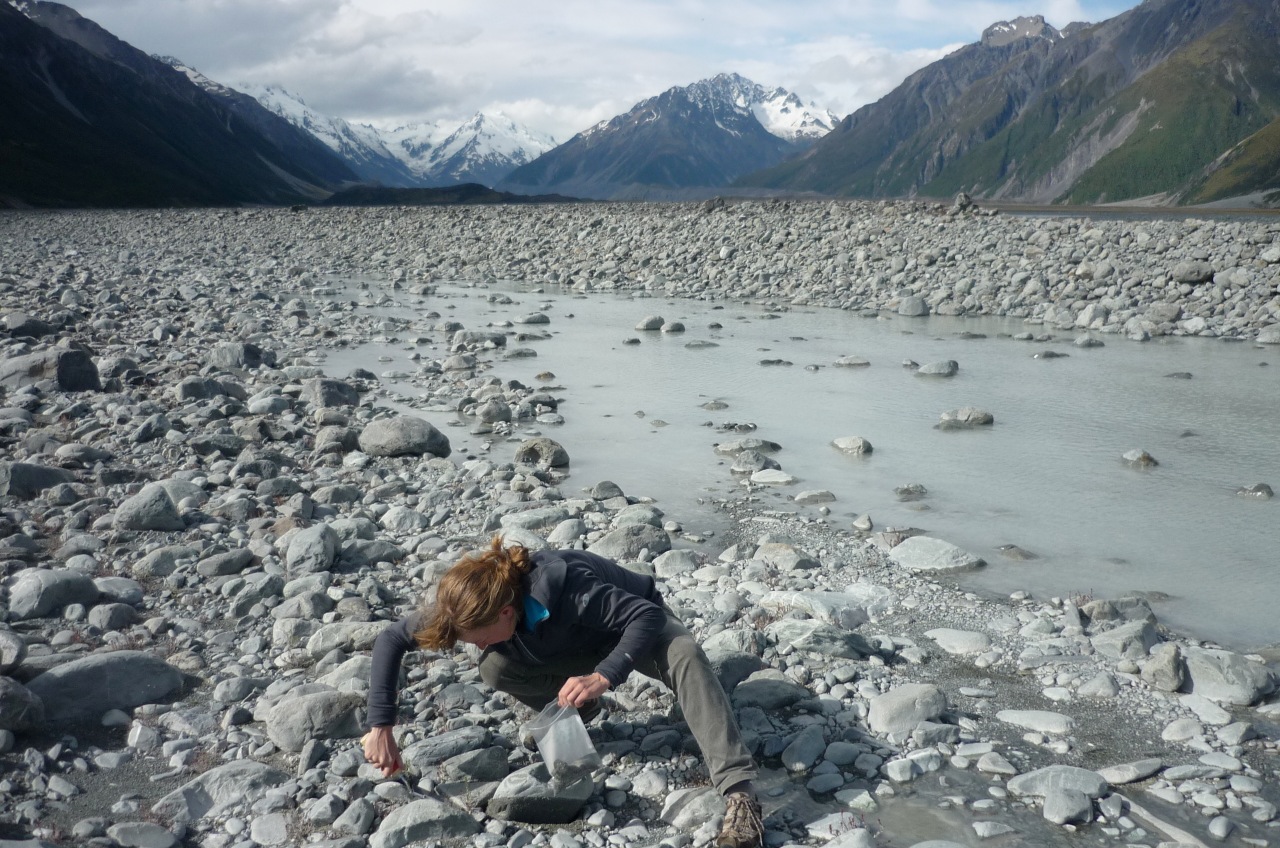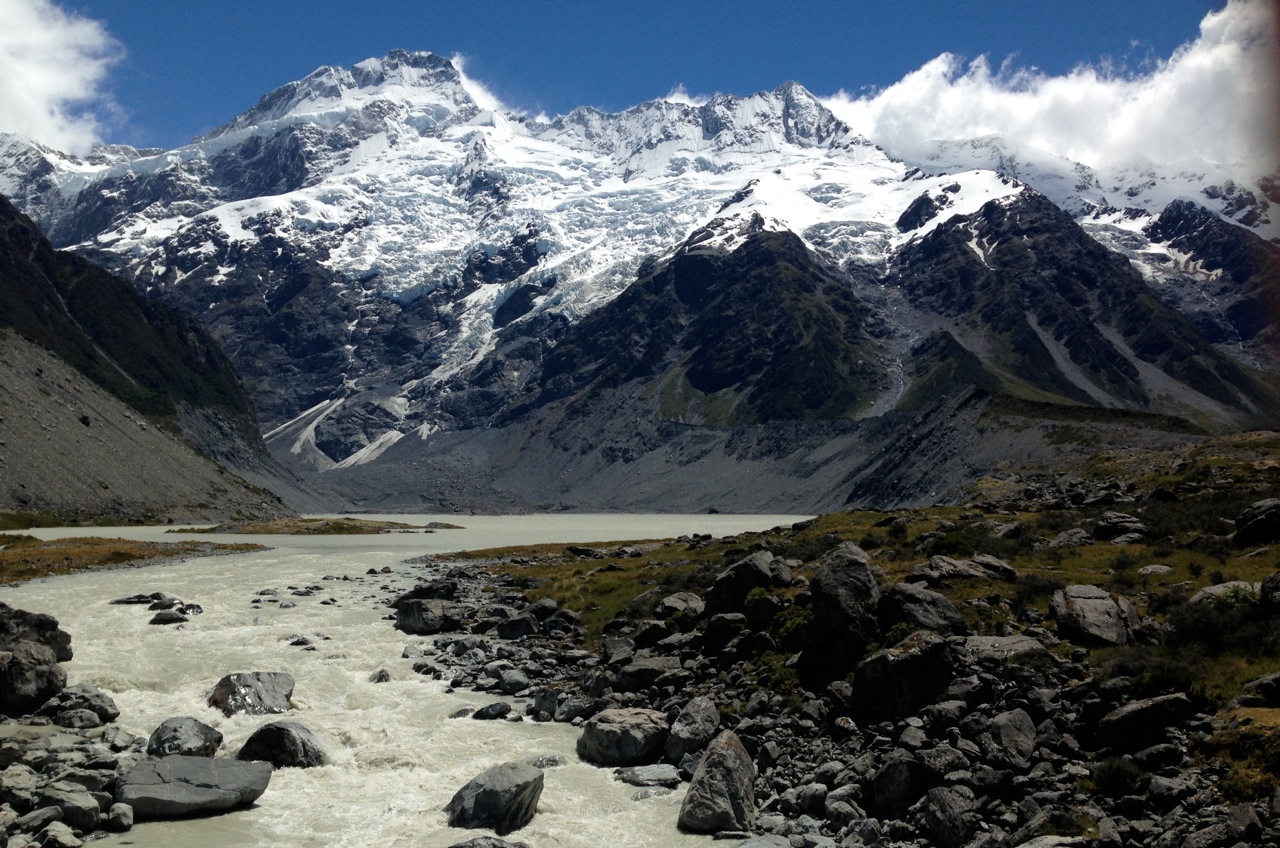
Bess Koffman enjoys getting dusty in the name of science. Currently a postdoctoral scientist at Columbia University's Lamont-Doherty Earth Observatory, Koffman recently returned from New Zealand's South Island, where she collected fine-grained sediments produced during the last Ice Age, around 18,000-30,000 years ago. These sediments will help Koffman and others pinpoint the sources of dust around the Southern Hemisphere, including Antarctica and the Southern Ocean. Why would we want to know where dust comes from? Because dust carries iron to the ocean, and iron is a critical nutrient for the single-celled algae (called phytoplankton) that form the base of the marine food web. When dust delivers extra iron to the surface of the Southern Ocean, these algae can grow rapidly, incorporating carbon into their bodies and potentially changing the global distribution of carbon between the atmosphere and ocean.
But, not all dust is created equal. Knowing where dust in the Southern Ocean came from during the last Ice Age is important to help us understand how the global carbon cycle—the balance and movement of carbon between the land, air, and ocean—functioned in the past compared to today.

For several decades, scientists have known that Earth's Ice Ages, or glacial periods, were very dusty times. In fact, on a global scale, dust deposition increased by about 2½ times during glacial periods. The increase in dust was even more pronounced in the polar regions, where it reached 25-35 times the level seen during warmer interglacial climates (the periods between the Ice Ages). These changes in dust supply have been credited with adding more iron to the ocean, leading to increased growth of phytoplankton, and in turn driving about 25% of the change in atmospheric carbon dioxide concentrations between glacial and interglacial periods.
So why was Ice Age Earth so dusty? It is likely that several factors were at play. First, colder climates are drier. Less precipitation allows dust to linger longer in the atmosphere, giving it more chance to get transported and deposited. Second, the Ice Age spawned changes in vegetation cover, glacier activity, and other factors that led to more dust being generated. And finally, changes in the strength, location, and gustiness of winds helped to mobilize more dust.

So how does one take something as small as a speck of dust and determine where it came from? In a word, isotopes. For most elements on the periodic table (like iron), there are multiple forms, or isotopes, of the element that exist in nature, each with a different mass. As an element moves from deep within Earth's mantle up to the surface, forming rock, natural radioactive decay causes the ratio of one isotope to another to change, giving the resulting bedrock its own special flavor. The particular mix of chemicals and isotopes that make up a rock is like a fingerprint, a unique pattern that makes it possible to distinguish rock from one region from another. Fortunately for scientists like Koffman, the composition of mineral dust reflects these different geographic regions. And in the same way that a colored dye can be used to track the movement of water, the geochemical 'fingerprinting' of far-traveled dust can be used to trace its source, or provenance. It turns out that the most useful elements to study for this type of provenance work are strontium (Sr), neodymium (Nd), and lead (Pb). Though present in tiny (or trace) quantities and often obscure, these isotopes have proven to be useful tools in understanding important processes such as dust transport. For example, they have shown us that Patagonia, the arid region spanning southern Chile and Argentina, is the dominant source of dust to East Antarctica, and therefore to the southern Atlantic and Indian Oceans, during Ice Ages.
For several decades, scientists have known that Earth's Ice Ages, or glacial periods, were very dusty times. In fact, on a global scale, dust deposition increased by about 2½ times during glacial periods. The increase in dust was even more pronounced in the polar regions, where it reached 25-35 times the level seen during warmer interglacial climates (the periods between the Ice Ages). These changes in dust supply have been credited with adding more iron to the ocean, leading to increased growth of phytoplankton, and in turn driving about 25% of the change in atmospheric carbon dioxide concentrations between glacial and interglacial periods.
So why was Ice Age Earth so dusty? It is likely that several factors were at play. First, colder climates are drier. Less precipitation allows dust to linger longer in the atmosphere, giving it more chance to get transported and deposited. Second, the Ice Age spawned changes in vegetation cover, glacier activity, and other factors that led to more dust being generated. And finally, changes in the strength, location, and gustiness of winds helped to mobilize more dust.

But scientists have yet to determine the source of dust to West Antarctica and the Pacific part of the Southern Ocean.
Koffman is trying to fill this gap. As part of her postdoctoral work at Columbia, she is analyzing samples from several West Antarctic ice cores, looking at both modern and Ice Age dusts. She will compare the isotopic 'fingerprints' of these samples to those measured on New Zealand glacier-derived sediments, and to other potential source regions such as Australia and Patagonia. In this way, she hopes to trace the sources of dust to West Antarctica, and to see if New Zealand—though outsized by its cousin to the west—may have been an important player in sending fresh, iron-rich dust to the ocean during the last Ice Age.
Koffman's work is part of a larger collaborative project that includes Columbia University graduate student Alejandra Borunda, who is also working in Antarctica, and postdoctoral researcher Cristina Recasens, who studies dust provenance in Patagonia and the South Atlantic. The three are mentored by Columbia professors Michael Kaplan, Steven Goldstein and Gisela Winckler, and by Natalie Mahowald of Cornell University. By looking at many different parts of the Southern Hemisphere, the team hopes to improve scientific understanding of the role of dust in climate change.
